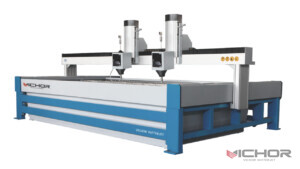
Principles of Abrasive Water Jet Machining: How This Technology Transforms Precision Cutting
In the world of modern manufacturing, efficiency and precision are paramount. One technology that stands out for its versatility and effectiveness is abrasive water jet machining. This non-traditional machining method has gained popularity across various industries due to its ability to cut a wide range of materials without inducing heat-affected zones. Understanding the principles of abrasive water jet machining is essential for engineers, designers, and manufacturers looking to optimize their production processes. This article delves into the core aspects of this innovative technique, breaking down its fundamental concepts, components, and applications. By exploring the key principles of abrasive water jet machining, you’ll gain insights into why it’s a preferred choice for complex cutting tasks. Whether you’re new to this field or seeking to deepen your knowledge, this overview will provide a comprehensive look at how abrasive water jet machining operates and why it matters in today’s industrial landscape.
What is Abrasive Water Jet Machining?
Abrasive water jet machining (AWJM) is a cutting process that utilizes a high-velocity stream of water mixed with abrasive particles to erode materials. The fundamental principles of abrasive water jet machining revolve around using kinetic energy to achieve precise cuts without thermal distortion. Unlike traditional methods like laser or plasma cutting, AWJM is a cold-cutting process, meaning it doesn’t generate heat that could alter material properties. This makes it ideal for sensitive materials such as composites, metals, and ceramics. The process begins with pressurizing water to extremely high levels, often exceeding 60,000 psi, and then forcing it through a small nozzle. Abrasive particles, typically garnet or aluminum oxide, are introduced into the stream, accelerating to speeds that can surpass 900 m/s. As this abrasive-laden jet impacts the workpiece, it mechanically removes material through erosion, resulting in clean, accurate cuts. The principles of abrasive water jet machining emphasize controllability and adaptability, allowing for intricate shapes and minimal waste. By mastering these basics, users can leverage AWJM for applications ranging from aerospace to art, highlighting its broad utility in modern manufacturing.
Key Components of the AWJM System
To fully grasp the principles of abrasive water jet machining, it’s crucial to understand its main components. The system consists of several integral parts that work together to generate the cutting jet. First, the high-pressure pump is the heart of the setup, responsible for pressurizing water to the required levels. These pumps can be intensifier-based or direct-drive, with intensifiers being common for their ability to deliver consistent pressure. Next, the abrasive delivery system stores and meters abrasive particles into the water stream. This includes a hopper and a metering device to ensure a steady flow of abrasives. The focusing tube or nozzle is another critical component, where the water and abrasives mix and accelerate. Made from durable materials like tungsten carbide, it focuses the jet into a narrow stream for precise cutting. Additionally, the catcher tank serves as a safety and containment unit, dissipating the energy of the jet after it passes through the material. Control systems, including CNC (Computer Numerical Control) units, govern the movement of the nozzle, enabling complex patterns and automation. Understanding these components is a key part of the principles of abrasive water jet machining, as they directly influence cutting efficiency, quality, and overall system performance. Regular maintenance of these parts ensures longevity and consistent results, making AWJM a reliable choice for high-precision tasks.
The Machining Process and Material Removal Mechanism
The core of the principles of abrasive water jet machining lies in its material removal mechanism, which is purely mechanical and based on erosion. The process starts with water being pressurized and then expelled through a small orifice, forming a coherent jet. Abrasive particles are injected into this jet, where they gain kinetic energy and become the primary cutting agents. When this abrasive-water mixture strikes the workpiece, the high-velocity particles impact the surface, causing micro-fractures and material dislodgement. This erosion process is highly controlled, allowing for precise depth and shape control. The principles of abrasive water jet machining involve several factors that affect material removal, such as abrasive type, size, and flow rate, as well as water pressure and traverse speed. For instance, harder abrasives like boron carbide can cut tougher materials, while finer particles produce smoother finishes. The absence of heat in this process prevents changes in material microstructure, such as hardening or cracking, which is a significant advantage over thermal methods. Moreover, the jet’s omnidirectional cutting capability enables it to handle complex geometries and layered materials without tool wear issues. By optimizing parameters like standoff distance and nozzle design, operators can enhance cutting speed and surface quality, demonstrating the adaptability embedded in the principles of abrasive water jet machining. This mechanism not only ensures high precision but also reduces environmental impact, as it typically uses water and natural abrasives.
Advantages of Using Abrasive Water Jet Machining
One of the most compelling aspects of the principles of abrasive water jet machining is the array of advantages it offers. First and foremost, it is a cold-cutting process, meaning it doesn’t generate heat that could compromise material integrity. This makes it suitable for temperature-sensitive materials like plastics, glass, and heat-treated metals. Additionally, AWJM is highly versatile, capable of cutting virtually any material, including metals, ceramics, stone, and composites, without the need for tool changes. The principles of abrasive water jet machining also emphasize minimal mechanical stress on the workpiece, reducing the risk of distortion or damage. This is particularly beneficial for thin or fragile materials. Another advantage is the environmental friendliness; the process primarily uses water and natural abrasives, producing no hazardous fumes or waste, unlike chemical or thermal methods. Furthermore, AWJM allows for high precision and intricate detailing, thanks to computer-controlled navigation. This results in narrow kerf widths and tight tolerances, essential for industries like aerospace and automotive. The ability to cut thick materials—up to several inches—in a single pass adds to its efficiency, reducing production time and costs. By adhering to the principles of abrasive water jet machining, users can achieve superior surface finishes with minimal secondary processing, streamlining manufacturing workflows. These benefits collectively make AWJM a sustainable and cost-effective solution for diverse applications.
Applications and Industries Where AWJM Excels
The principles of abrasive water jet machining enable its use across a wide spectrum of industries, thanks to its adaptability and precision. In the aerospace sector, AWJM is employed for cutting composite materials, titanium alloys, and other high-strength components without inducing thermal stress, which is critical for safety and performance. The automotive industry utilizes it for prototyping, trimming parts, and fabricating custom components, leveraging its ability to handle various materials quickly. In architecture and construction, abrasive water jet machining is ideal for cutting stone, glass, and tiles for decorative elements and structural parts, offering intricate designs that other methods can’t achieve. The electronics industry benefits from AWJM for precision cutting of circuit boards and delicate components, where heat-free processing prevents damage. Additionally, the art and design field embraces this technology for creating detailed sculptures and installations from materials like metal and marble. The medical sector uses AWJM for manufacturing implants and devices from biocompatible materials, ensuring clean cuts without contamination. Understanding the principles of abrasive water jet machining in these contexts highlights its role in enhancing productivity and innovation. As industries evolve toward customization and sustainability, AWJM’s flexibility and eco-friendly nature position it as a key enabler of advanced manufacturing, demonstrating how the principles of abrasive water jet machining drive real-world solutions.
Limitations and Considerations in AWJM
While the principles of abrasive water jet machining offer numerous benefits, it’s important to acknowledge its limitations and operational considerations. One key drawback is the relatively slow cutting speed compared to thermal methods like laser cutting, especially for thick, hard materials. This can impact production rates in high-volume settings. Additionally, the process consumes significant amounts of water and abrasives, leading to operational costs and waste management challenges. The principles of abrasive water jet machining also involve nozzle wear, which requires regular replacement to maintain cutting accuracy, adding to maintenance expenses. Another consideration is the potential for taper in cuts, where the kerf width varies from top to bottom; this can be mitigated through advanced control techniques but remains a factor in precision work. Noise and safety concerns are also present, as high-pressure systems can be loud and require proper shielding to prevent accidents. Moreover, the quality of the cut surface might include a slight roughness or “striation” pattern, which may need post-processing for applications requiring smooth finishes. By understanding these limitations within the principles of abrasive water jet machining, users can make informed decisions, such as combining AWJM with other methods or optimizing parameters for specific tasks. Despite these challenges, the advantages often outweigh the drawbacks, making AWJM a valuable tool in many scenarios.

Future Trends and Innovations in AWJM
The principles of abrasive water jet machining continue to evolve with technological advancements, paving the way for future innovations. Research is focused on improving efficiency, such as developing higher-pressure pumps that can exceed 100,000 psi for faster cutting and better energy utilization. Automation and AI integration are also on the rise, enabling real-time monitoring and adjustment of cutting parameters to enhance precision and reduce waste. Another trend involves eco-friendly abrasives and water recycling systems, aligning with global sustainability goals. The principles of abrasive water jet machining are being expanded to include hybrid processes, where AWJM is combined with other techniques like milling or drilling to overcome limitations and offer comprehensive solutions. Additionally, advancements in nozzle design and abrasive materials aim to reduce wear and extend equipment life, lowering long-term costs. As industries demand more customization and faster turnaround, these innovations will make AWJM even more accessible and effective. By staying updated on these trends, professionals can leverage the full potential of the principles of abrasive water jet machining, ensuring they remain competitive in a dynamic manufacturing landscape.
FAQs on Principles of Abrasive Water Jet Machining
Q1: What are the basic principles of abrasive water jet machining?
A1: The basic principles of abrasive water jet machining involve using a high-velocity stream of water mixed with abrasive particles to cut materials through mechanical erosion. This process relies on kinetic energy rather than heat, allowing for precise, cold cuts without thermal damage to the workpiece.
Q2: How does abrasive water jet machining differ from pure water jet cutting?
A2: While both use high-pressure water, abrasive water jet machining incorporates abrasive particles into the stream for enhanced cutting power, enabling it to handle harder materials like metals and ceramics. Pure water jet cutting is typically used for softer materials like foam or rubber and doesn’t involve abrasives.
Q3: What materials can be processed using abrasive water jet machining?
A3: Abrasive water jet machining can cut a wide range of materials, including metals (e.g., steel, aluminum), composites, ceramics, glass, stone, and plastics. Its versatility stems from the mechanical cutting action, which avoids heat-related issues.
Q4: What are the main advantages of following the principles of abrasive water jet machining?
A4: Key advantages include no heat-affected zones, high versatility across materials, minimal mechanical stress, environmental friendliness, and the ability to produce intricate cuts with high precision. These make it ideal for sensitive and complex applications.
Q5: What are common challenges in abrasive water jet machining?
A5: Common challenges include slower cutting speeds for thick materials, nozzle wear requiring frequent maintenance, taper in cuts, and higher operational costs due to water and abrasive consumption. However, these can be managed with proper parameter optimization and maintenance schedules.
By covering these aspects, this article provides a thorough understanding of the principles of abrasive water jet machining, helping readers appreciate its role in modern industry. If you have more questions, feel free to explore further resources or consult with experts in the field.
continue reading
Related Posts
- 1155 words5.8 min read

